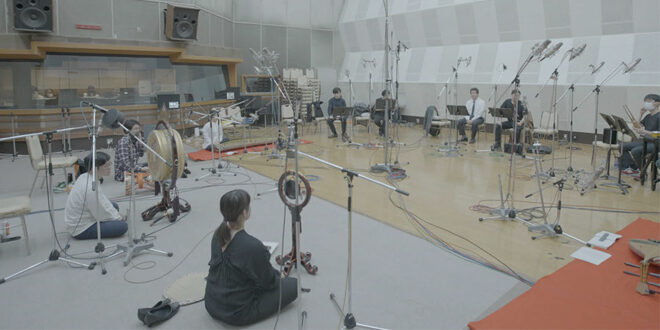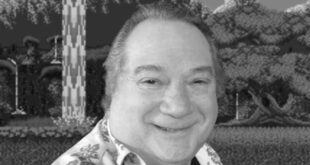Composer and producer Cody Matthew Johnson chronicles the thought processes, ambition and effort that went into Trek to Yomi. a game that is more than a visual ode to the films of Akira Kurosawa.
Our final recording session for Trek to Yomi ended with the four present members of our score production and recording team laying on the floor inside the Studio D reverb chamber at The Village Studios in Los Angeles with the death throes of what sounded like japanese hellscapes washing over us. “This is a game about the Edo Period and feudal Japan, inspired by the cinematic style of Akira Kurosawa… how did I end up here – continuously reamping a feedback loop of abstract, distorted, and borderline demonically perverse traditional Japanese instruments.” I found myself questioning, “had I made the right decision?”, “had we strayed too far from the path of exclusively using traditional edo period japanese instruments like shakuhachi, shamisen, and taiko drums?” The short of it: no.
For those unfamiliar, Trek to Yomi is a narrative hack-and-slash game rooted in the Edo Period and feudal Japan, but treks far beyond that setting, and is deeply inspired by Japanese cinema, specifically the films of the legendary Akira Kurosawa. It was decided early on to impose clear limitations on instrumentations and musicality – the score was to be kept as rooted and honorific to the music, time, and place of the game as possible. Instead of scoring in the spirit of Fumio Hayasaka, composer of many of Kurosawa-san’s films, we would only use instruments that existed during or near the Edo Period.
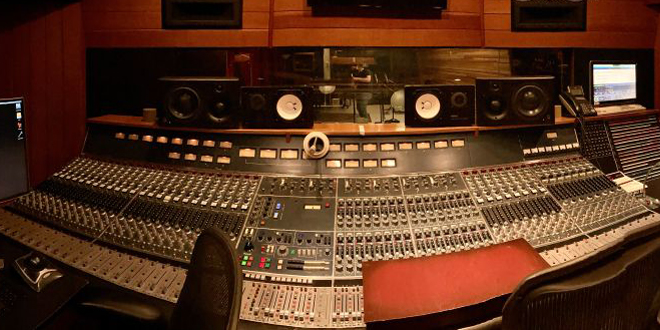
The game kicks off with a pastoral scene of a beautifully crafted village to show the status quo of Trek to Yomi – and the music tracks, featuring a sparse number of instruments and carefully following the musicality of traditional Japanese music. My co-composer Yoko Honda did a marvelous job on the music for this, which you can hear on the piece “Sakura Fubuki” from the Trek to Yomi (Original Soundtrack) album. As the narrative progresses, protagonist Hiroki ventures towards a turning point in the game. It is called Trek to Yomi after all, and a large portion of the game is in this mysterious place called Yomi. “Pestilence” from the soundtrack album showcases a transitional point of the game where Hiroki is in the beginnings of his journey into Yomi.
Yomi is a purgatory-like afterlife place, and contains any and all degrees of the afterlife you can imagine: from the awesome and breathtaking, to putrid and abstract hellscapes. It is a common mythology shared by a crosssection of cultures with a strong presence of Shintoism. All of this begs the question, “what does Yomi sound like?” Because of its unknowable and abstract nature, I had free reign to creatively experiment and decide what this part of the game would sound like. In my research, I learned of an ensemble commonly found in Japan, but particularly rare and specialized elsewhere in the world, called a gagaku. This gagaku ensemble and style of music was brought to Japan from China in the 8th century and is performed as court and ceremonial music. Gagaku serves to illustrate these links between Shintoism and Japan.
This style of music has a uniquely hypnotic expressiveness and nearly dissonant tonality, featuring a myriad of fascinating double reed, windpipe, and flute instruments. Out of respect for the rich extensive history of this music, and a desire for pieces to be deeply rooted in Japanese tradition, we recorded with some of the best – if not the very best – gagaku players in the world based in Tokyo, rather than compose it ourselves. There is hundreds of years worth of musical history here to respect after all. The first step towards creating the sound of Yomi was complete. Early visual references of Yomi for the game showed progressively eerie abstractions, and the music needed to match! Like Hiroki venturing deeper into Yomi, as we travel away from the source of a sound it lowers in pitch – this is called the Doppler Effect (think of an ambulance driving away down the street as its siren slowly drops in pitch).
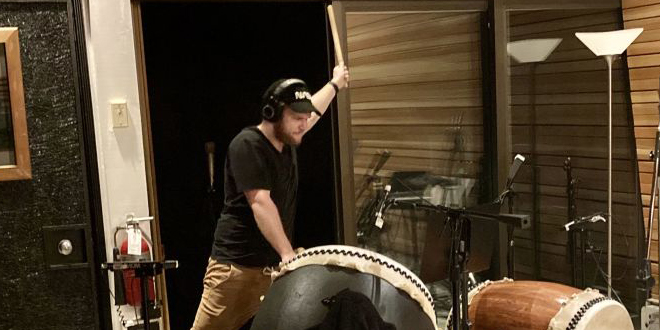
In my experimentations of stretching and pitching Edo period instruments, I found it creating compelling and unnerving atmospheres and textures that perfectly suited Yomi. The deeper Hiroki goes, the more distorted, stretched, and abstract the music becomes. The experimentally stretched and processed Gagaku recordings specifically became the anchoring sound of this unknowable and mysterious place called Yomi. The audiophile in me is always trying to extract as much information out of a recording, and knowing some rudimentary concepts, such as the overtone series of reed and wind flutes, I knew there would be a treasure trove of super-sonic concept beyond the audible range of the human ear.
As we stretch audio, the pitch and frequencies descend (of course this depends on your stretching algorithm). Specifically, if you stretch the audio to twice its original length the pitch drops an octave, but we start losing higher frequencies and transient intelligibility. I was stretching some of the content for early demos four or more times to truly smear the content into a deranged place. So how do we access that supersonic content and increase fidelity after mangling the source audio? Ultrasonic microphones and the highest fidelity of recording possible.
Working with Mary Shinohara, a marvelous engineer based in Tokyo, at Avaco Studio, we set up an array of ultrasonic microphones, and positioned the gagaku players in a circle in lieu of their traditional triangular arrangement with an ambisonic microphone at the center. And just as Yomi swirls around Hiroki on his journey, I processed the recording ambisonically to achieve the effect of being surrounded by this ensemble and “swirl” around the listener. We are very proud of the recordings we were able to capture for Trek To Yomi. The results are a special recording of a rare musical expression, and arguably the highest fidelity recording of a gagaku ever produced. For this reason, we released the full versions of the gagaku pieces we recorded as a companion disc on the Trek to Yomi (Original Soundtrack). We then took our multitrack recordings at 192kHz / 32bit and started doing what sound designers do best – absolutely destroying the recordings.
Loads of time went into creatively processing and mangling the recordings while preserving all of that pristine ultrasonic content captured in the recording session. I’m grateful for my 7,1 Mac Pro, which was able to simultaneously handle hundreds of gigabytes worth of multitrack 192kHz gagaku being time stretched and processed in surround alongside hundreds of tracks of drums, flutes, koto, shamisen, and voice – this technological feat of strength would have been impossible a couple of short years ago. These resampled and designed gagaku along with the stretched multitrack can be heard littering the last half of the game, serving as the musical base of atmosphere as well as all the nasty effects, melodies, and thrilling unadulterated tension throughout.
After composing the entire two hour plus score we moved to recording. We recorded with talented players across the globe – remote of course, given the entirety of this score was created and recorded during the pandemic – and had a core group of soloists. During our last recording session at The Village Studios in Los Angeles, we discovered a reverb chamber in Studio D where we were recording.
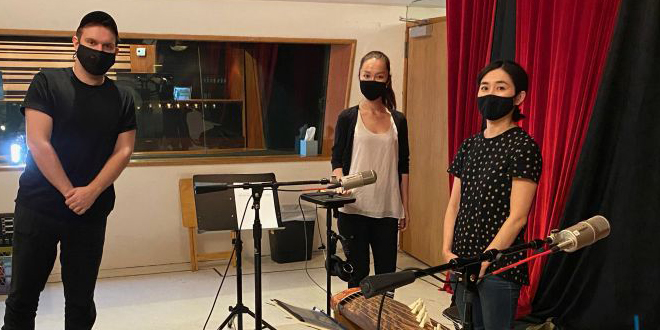
Immediately after finishing the last take I begged the engineer to send the stems of cue (a cue that became the track “The Echoes of Yomi” on the soundtrack album) through the chamber. So we sent each stem – starting with winds, stringed instruments, and so on – through the reverb chamber. And on return from the reverb chamber I sent the signal ever so slightly back into the reverb chamber to have a small amount of feedback. It sounded so ethereal and cool! I then sent the sum of those stems into the reverb chamber and again had a small amount of the incoming reverb signal fed back into the reverb chamber. And then we did it again. And again. And then again. And then one last time for good measure.
By the end of the recording process the original sounds themselves had blurred behind a cacophonous metallic rattle that was the nearly self-oscillating pure tone of the reverb chamber itself – with all of its imperfections and glory. On the last pass I gathered the team and pulled open the monstrously heavy reverb chamber door – we were blasted with such force and energy unlike I’ve ever felt. And so we entered the chamber as if prepared for a final boss battle and laid upon the floor so that the outlandish otherworldly hellscapes would wash over us – hellscapes derived from historical traditional instruments performed with such immaculate and honorific respect, then unapologetically subjected to sonic destruction, distortion, and perversion.
Returning back to the original question that started our personal trek to Yomi, “Had I made the right decision?”. After countless hours of research, the utmost respect for the instruments and culture, pushing the limits of what is sonically possible, squeezing every last sonic drop from these instruments, and all produced during a global pandemic, the answer I had found for myself was a resounding, “yes.”
Ultimately, that is an answer that each player will need to decide on their own personal trek to Yomi.

 MCV/DEVELOP News, events, research and jobs from the games industry
MCV/DEVELOP News, events, research and jobs from the games industry
